| Danwon pungsokdo cheop | |
| Hangul | 단원풍속도첩 |
|---|---|
| Hanja | 檀園風俗圖帖 |
| Revised Romanization | Danwon pungsokdo cheop |
| McCune–Reischauer | Tanwŏn p'ungsokto ch'ŏp |
Danwon pungsokdo cheop (Korean: 단원풍속도첩; Hanja: 檀園風俗圖帖) is an album of genre painting (pungsokhwa or pungsokdo) drawn by Kim Hong-do during the late Joseon period. It was named after Kim's art name, Danwon, and contains 25 paintings. The album is painted with light watercolor on Korean paper. Each painting depicts vividly common people's daily life in the Joseon period.
Danwon pungsokdo cheop is designated as the 527th National Treasure of South Korea and held by National Museum of Korea located in Yongsan District, Seoul, South Korea.
At work places
| Picture | Title | Korean title |
|---|---|---|
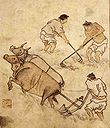
|
Plowing a rice field | 논갈이; 耕畓 |

|
Threshing rice | 타작; 打作 |

|
Shoeing a horse | 편자박기; 蹄鐵 |
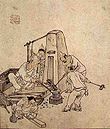
|
A smithy | 대장간 |

|
Slicing tobacco | 담배썰기 |

|
Tiling Giwa | 기와이기; 葺瓦 |

|
Fishing | 고기잡이; 漁場 |
Daily life
| Picture | Title | Korean title |
|---|---|---|

|
Weaving | 길쌈; 織造 |

|
Weaving a mat | 자리짜기; 編席 |

|
A laundry place | 빨래터; 漂母 |
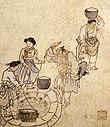
|
By a well | 우물가; 井邊 |

|
A divination sign | 점괘; 占卦 |

|
Lunch time | 점심 |

|
Jumak (tavern) | 주막; 酒幕 |
On the streets
| Picture | Title | Korean title |
|---|---|---|
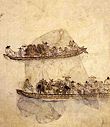
|
Ferryboats | 나룻배 |

|
Peddling | 행상; 行商 |

|
On the way to a market | 장터길 |

|
On the way for wedding | 신행; 新行 |
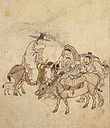
|
Bursting into laughter on a street | 노상파안; 路上破顔 |
Pastime
| Picture | Title | Korean title |
|---|---|---|

|
A gonu nori | 고누놀이 |

|
A dancing boy | 무동; 舞童 |

|
Ssireum (Korean wrestling) | 씨름; 相撲 |

|
Shooting an arrow | 활쏘기; 射弓 |
Education
| Picture | Title | Korean title |
|---|---|---|
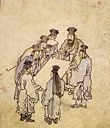
|
Appreciating a picture | 서화감상; 審觀 |
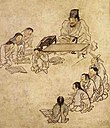
|
Seodang | 서당; 書堂 |
See also
External links
- (in Korean) Brief information about Danwon pungsokdo cheop from 한국학연구소
- (in Korean) Brief information about Danwon pungsokdo cheop from Yahoo Korea dictionary
- (in Korean) 옛사람들의 생활모습 from 문화재청
- (in Korean) Brief information about Danwon pungsokdo cheop from Encyber dictionary
- (in Korean) 단원풍속도첩<25폭>(檀園風俗圖帖<二十五幅> from 문화재정보센터
This Korea-related article is a stub. You can help Misplaced Pages by expanding it. |